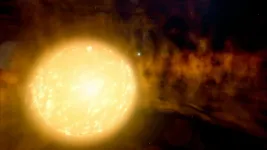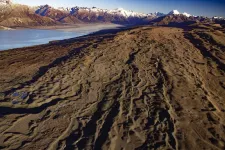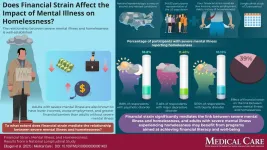(Press-News.org) Astronomers have painted their best picture yet of an RV Tauri variable, a rare type of stellar binary where two stars - one approaching the end of its life - orbit within a sprawling disk of dust. Their 130-year dataset spans the widest range of light yet collected for one of these systems, from radio to X-rays.
"There are only about 300 known RV Tauri variables in the Milky Way galaxy," said Laura Vega, a recent doctoral recipient at Vanderbilt University in Nashville, Tennessee. "We focused our study on the second brightest, named U Monocerotis, which is now the first of these systems from which X-rays have been detected."
A paper describing the findings, led by Vega, was published in The Astrophysical Journal.
The system, called U Mon for short, lies around 3,600 light-years away in the constellation Monoceros. Its two stars circle each other about every six and a half years on an orbit tipped about 75 degrees from our perspective.
The primary star, an elderly yellow supergiant, has around twice the Sun's mass but has billowed to 100 times the Sun's size. A tug of war between pressure and temperature in its atmosphere causes it to regularly expand and contract, and these pulsations create predictable brightness changes with alternating deep and shallow dips in light - a hallmark of RV Tauri systems. Scientists know less about the companion star, but they think it's of similar mass and much younger than the primary.
The cool disk around both stars is composed of gas and dust ejected by the primary star as it evolved. Using radio observations from the Submillimeter Array on Maunakea, Hawai'i, Vega's team estimated that the disk is around 51 billion miles (82 billion kilometers) across. The binary orbits inside a central gap that the scientists think is comparable to the distance between the two stars at their maximum separation, when they're about 540 million miles (870 million kilometers) apart.
When the stars are farthest from each other, they're roughly aligned with our line of sight. The disk partially obscures the primary and creates another predictable fluctuation in the system's light. Vega and her colleagues think this is when one or both stars interact with the disk's inner edge, siphoning off streams of gas and dust. They suggest that the companion star funnels the gas into its own disk, which heats up and generates an X-ray-emitting outflow of gas. This model could explain X-rays detected in 2016 by the European Space Agency's XMM-Newton satellite.
"The XMM observations make U Mon the first RV Tauri variable detected in X-rays," said Kim Weaver, the XMM U.S. project scientist and an astrophysicist at NASA's Goddard Space Flight Center in Greenbelt, Maryland. "It's exciting to see ground- and space-based multiwavelength measurements come together to give us new insights into a long-studied system."
In their analysis of U Mon, Vega's team also incorporated 130 years of visible light observations.
The earliest available measurement of the system, collected on Dec. 25, 1888, came from the archives of the American Association of Variable Star Observers (AAVSO), an international network of amateur and professional astronomers headquartered in Cambridge, Massachusetts. AAVSO provided additional historical measurements ranging from the mid-1940s to the present.
The researchers also used archived images cataloged by the Digital Access to a Sky Century @ Harvard (DASCH), a program at the Harvard College Observatory in Cambridge dedicated to digitizing astronomical images from glass photographic plates made by ground-based telescopes between the 1880s and 1990s.
U Mon's light varies both because the primary star pulsates and because the disk partially obscures it every 6.5 years or so. The combined AAVSO and DASCH data allowed Vega and her colleagues to spot an even longer cycle, where the system's brightness rises and falls about every 60 years. They think a warp or clump in the disk, located about as far from the binary as Neptune is from the Sun, causes this extra variation as it orbits.
Vega completed her analysis of the U Mon system as a NASA Harriett G. Jenkins Predoctoral Fellow, a program funded by the NASA Office of STEM Engagement's Minority University Research and Education Project.
"For her doctoral dissertation, Laura used this historical dataset to detect a characteristic that would otherwise appear only once in an astronomer's career," said co-author Rodolfo Montez Jr., an astrophysicist at the Center for Astrophysics | Harvard & Smithsonian, also in Cambridge. "It's a testament to how our knowledge of the universe builds over time."
Co-author Keivan Stassun, an expert in star formation and Vega's doctoral advisor at Vanderbilt, notes that this evolved system has many features and behaviors in common with newly formed binaries. Both are embedded in disks of gas and dust, pull material from those disks, and produce outflows of gas. And in both cases, the disks can form warps or clumps. In young binaries, those might signal the beginnings of planet formation.
"We still have questions about the feature in U Mon's disk, which may be answered by future radio observations," Stassun said. "But otherwise, many of the same characteristics are there. It's fascinating how closely these two binary life stages mirror each other."
INFORMATION:
By Jeanette Kazmierczak
NASA's Goddard Space Flight Center, Greenbelt, Md.
Water is perhaps Earth's most critical natural resource. Given increasing demand and increasingly stretched water resources, scientists are pursuing more innovative ways to use and reuse existing water, as well as to design new materials to improve water purification methods. Synthetically created semi-permeable polymer membranes used for contaminant solute removal can provide a level of advanced treatment and improve the energy efficiency of treating water; however, existing knowledge gaps are limiting transformative advances in membrane technology. One basic problem is ...
BOSTON -- SARS-CoV-2, the virus that causes COVID-19, has mutated throughout the pandemic. New variants of the virus have arisen throughout the world, including variants that might possess increased ability to spread or evade the immune system. Such variants have been identified in California, Denmark, the U.K., South Africa and Brazil/Japan. Understanding how well the COVID-19 vaccines work against these variants is vital in the efforts to stop the global pandemic, and is the subject of new research from the Ragon Institute of MGH, MIT and Harvard and Massachusetts General Hospital.
In a study recently published in Cell, Ragon Core Member Alejandro Balazs, PhD, found that the neutralizing antibodies induced by the ...
Orono, Maine -- The origins of ice age climate changes may lie in the Southern Hemisphere, where interactions among the westerly wind system, the Southern Ocean and the tropical Pacific can trigger rapid, global changes in atmospheric temperature, according to an international research team led by the University of Maine.
The mechanism, dubbed the Zealandia Switch, relates to the general position of the Southern Hemisphere westerly wind belt -- the strongest wind system on Earth -- and the continental platforms of the southwest Pacific Ocean, and their control on ocean currents. Shifts in the latitude of the westerly winds affects the strength ...
March 12, 2021 - Financial strains like debt or unemployment are significant risk factors for becoming homeless, and even help to explain increased risk of homelessness associated with severe mental illness, reports a study in a supplement to the April issue of Medical Care. The journal is published in the Lippincott portfolio by Wolters Kluwer.
The findings "suggest that adding financial well-being as a focus of homelessness prevention efforts seems promising, both at the individual and community level," according to the new research, led by Eric Elbogen, PhD, of the US Department of Veterans Affairs (VA) National Center on Homelessness and Duke University School of Medicine. The study appears as part of a special issue on ...
Mantle cell lymphoma is a malignant disease in which intensive treatment can prolong life. In a new study, scientists from Uppsala University and other Swedish universities show that people with mantle cell lymphoma who were unmarried, and those who had low educational attainment, were less often treated with a stem-cell transplantation, which may result in poorer survival. The findings have been published in the scientific journal Blood Advances.
Patients diagnosed with a mantle cell lymphoma (MCL) where the disease has spread receive intensive treatment with cytotoxic drugs and stem-cell transplantation. In a new study, researchers looked at which people are more likely to be offered transplants, and compared survival between those ...
WINSTON-SALEM, NC - March 12, 2021 - The Wake Forest Institute for Regenerative Medicine is investigating how cats with chronic kidney disease could someday help inform treatment for humans.
In humans, treatment for chronic kidney disease -- a condition in which the kidneys are damaged and cannot filter blood as well as they should -- focuses on slowing the progression of the organ damage. The condition can progress to end-stage kidney failure, which is fatal without dialysis or a kidney transplant. An estimated 37 million people in the US suffer from chronic kidney disease, according to the Centers for Disease Control.
The American Veterinary Medical Association estimates there are about 58 million ...
If you were given "ultrasound" in a word association game, "sound wave" might easily come to mind. But in recent years, a new term has surfaced: bubbles. Those ephemeral, globular shapes are proving useful in improving medical imaging, disease detection and targeted drug delivery. There's just one glitch: bubbles fizzle out soon after injection into the bloodstream.
Now, after 10 years' work, a multidisciplinary research team has built a better bubble. Their new formulations have resulted in nanoscale bubbles with customizable outer shells -- so small and durable that they can travel to and penetrate some of the ...
(BOSTON) -- There is a great need to generate various types of cells for use in new therapies to replace tissues that are lost due to disease or injuries, or for studies outside the human body to improve our understanding of how organs and tissues function in health and disease. Many of these efforts start with human induced pluripotent stem cells (iPSCs) that, in theory, have the capacity to differentiate into virtually any cell type in the right culture conditions. The 2012 Nobel Prize awarded to Shinya Yamanaka recognized his discovery of a strategy that can reprogram adult cells to become iPSCs ...
Arlington, Va. (March 12, 2021)--A new supplement offering guidance on severe COVID-19 management in resource-limited settings is now available on the American Journal of Tropical Medicine (AJTMH) website. Pragmatic Recommendations for the Management of Hospitalized COVID-19 Patients in Low- and Middle-Income Countries was coordinated by a COVID-LMIC Task Force headed by Alfred Papali, MD, of Atrium Health, Charlotte, NC, and Marcus Schultz, MD, PhD, of Mahidol University, Bangkok, Thailand; University of Oxford, United Kingdom; and Amsterdam University Medical Centers, The Netherlands. ...
BUFFALO, N.Y. - University at Buffalo computer scientists have developed a tool that automatically identifies deepfake photos by analyzing light reflections in the eyes.
The tool proved 94% effective in experiments described in a paper accepted at the IEEE International Conference on Acoustics, Speech and Signal Processing to be held in June in Toronto, Canada.
"The cornea is almost like a perfect semisphere and is very reflective," says the paper's lead author, Siwei Lyu, PhD, SUNY Empire Innovation Professor in the Department of Computer Science and Engineering. "So, anything that is coming to the eye with a light emitting from those sources will have an image on ...





